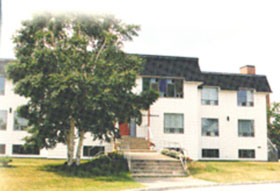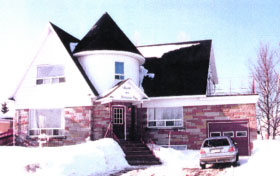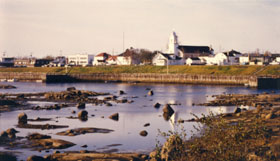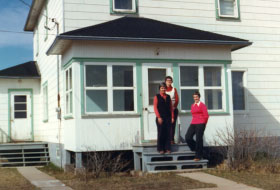1947 to present
HAUTERIVE BAIE COMEAU

Hotel-Dieu (1950-1972)
Established in 1950, this general hospital expanded throughout the years to a 150 bed capacity. About 20 Hospitallers of Saint Joseph served the sick and one of them was the administrator until 1972, at which time the hospital was ceded to the Provincial Government. Four years later, there were no longer Hospitallers in the hospital, but many of them became engaged in new services in the area.
Point de Rencontre (1975-)
This house was born from the heart of Sister Yvonne de la Mirande who established a S.O.S. call service as well as a mutual aid relief center in Manicouagan. This small center ministered to a majority of suicidal men, alcoholics and drug addicts. In 1979 it moved to a new house built expressly for these men. Point de Rencontre, open 24/7 is recognized for its in - house correctional services offering therapy for one to two months, individual counseling, group meetings, in-service and short-term relief services. Those who wish can pursue therapeutic follow-up externally. The last Hospitaller left Point de Rencontre in 2005.
St. Joseph Residence (1992-2003)
After 20 years of service at Point de Rencontre, Sister Yvonne de la Mirande recognized that a certain number of suicidal persons, alcoholics and drug addicts who completed several phases of rehabilitation did not seem to be able to gain a foot hold in life. Responding to this reality, Sister Yvonne formed a new corporation in 1992 which purchased property and a former school which was renovated, furnished and renamed Saint Joseph Residence. In 2003 the residence was closed due to Sister de la Mirande’s illness.
Home Nursing Service
In 1976, Sister Denise Landry initiated a Home Nursing service in a suburb with six service centers with grants received from the Minister of Health. She was also engaged in nursing education for the clinics on the North Shore.
BAIE-COMEAU
Centre Amitie Nazareth (1983-)
This center founded in 1983 by Sister Francoise Turcotte is a long-term residence for physically and mentally challenged persons in a family-style community of faith and hope. The basic characteristic of this center is that the poor person is at the heart of the community in relationships of love, trust, simplicity and sharing.
Vallee des Roseaux (19 88)
88)
This project to open a palliative care home was launched in 1982 by lay persons who were credentialed after following a course in care of the dying given by Sister Odette Lavalle, who was soon enthusiastically integrated into this group. A Board of Directors was formed and, in spite of limited financial resources, a 22 room house was purchased and furnished to receive seven patients at a time. Vallee des Roseaux opened its doors in May 1988. In 1994, Sister Odette passed on its leadership to another person so as to devote her time to the opening of a Palliative Care formation center. At the beginning of 2003, approximately 650 patients had been cared for at Vallee des Roseaux; the care-givers being present to mourn with the families and friends of the deceased..
PORT CARTIER (1974-1995)
 Bishop Gerard Couturier, Bishop of the diocese requested a religious presence in this region where there were two large factories attracting employees from several areas. The sisters accepted to come to visit and care for the sick, provide social services, and engage in adult education on a voluntary basis, along with the Sisters of the Good Shepherd. They participated in parish activities, committees for Well-being and Faith education, for which sister Pauline Maillé was responsible.
Bishop Gerard Couturier, Bishop of the diocese requested a religious presence in this region where there were two large factories attracting employees from several areas. The sisters accepted to come to visit and care for the sick, provide social services, and engage in adult education on a voluntary basis, along with the Sisters of the Good Shepherd. They participated in parish activities, committees for Well-being and Faith education, for which sister Pauline Maillé was responsible.
For many years the group of four was maintained. However, like all other situations, the number gradually diminished. Upon the arrival of the Sisters of Good Counsel from Chicoutimi, the presence of the two remaining Hospitallers remaining in Port Cartier was no longer necessary. Sister Huguette Laramee and Denise Lefebvre closed the house on November 18, 1995 and returned to the motherhouse in Montreal.
NATASHQUAN (1974-1976)
 The Hotel-Dieu, Hauterive was responsible for nursing care in the fishing villages of Natashquan close to 1600 km north. Sister Madeleine St. Michel, Director of Nursing at the hospital in Hauterive and Sister Leona Landry took charge of the dispensary in Natashquan in September 1974. They served a population of approximately 1,500 persons from four different areas one of which was an Indian reservation. At that time, the highway ended in Sept-Iles so the only means of transportation was by plane, weather permitting , and by boat once a week. In the absence of a physician, the sisters responded to the health needs, did preventive medicine in the villages and the schools.
The Hotel-Dieu, Hauterive was responsible for nursing care in the fishing villages of Natashquan close to 1600 km north. Sister Madeleine St. Michel, Director of Nursing at the hospital in Hauterive and Sister Leona Landry took charge of the dispensary in Natashquan in September 1974. They served a population of approximately 1,500 persons from four different areas one of which was an Indian reservation. At that time, the highway ended in Sept-Iles so the only means of transportation was by plane, weather permitting , and by boat once a week. In the absence of a physician, the sisters responded to the health needs, did preventive medicine in the villages and the schools.
They escorted the critically ill and accident victims by plane for treatment and care in the larger centers. They were also responsible for liturgical celebrations in the parish. The Congregation withdrew from this mission in 1976.
HAUTERIVE BAIE COMEAU

Hotel-Dieu (1950-1972)
Established in 1950, this general hospital expanded throughout the years to a 150 bed capacity. About 20 Hospitallers of Saint Joseph served the sick and one of them was the administrator until 1972, at which time the hospital was ceded to the Provincial Government. Four years later, there were no longer Hospitallers in the hospital, but many of them became engaged in new services in the area.
Point de Rencontre (1975-)
This house was born from the heart of Sister Yvonne de la Mirande who established a S.O.S. call service as well as a mutual aid relief center in Manicouagan. This small center ministered to a majority of suicidal men, alcoholics and drug addicts. In 1979 it moved to a new house built expressly for these men. Point de Rencontre, open 24/7 is recognized for its in - house correctional services offering therapy for one to two months, individual counseling, group meetings, in-service and short-term relief services. Those who wish can pursue therapeutic follow-up externally. The last Hospitaller left Point de Rencontre in 2005.
St. Joseph Residence (1992-2003)
After 20 years of service at Point de Rencontre, Sister Yvonne de la Mirande recognized that a certain number of suicidal persons, alcoholics and drug addicts who completed several phases of rehabilitation did not seem to be able to gain a foot hold in life. Responding to this reality, Sister Yvonne formed a new corporation in 1992 which purchased property and a former school which was renovated, furnished and renamed Saint Joseph Residence. In 2003 the residence was closed due to Sister de la Mirande’s illness.
Home Nursing Service
In 1976, Sister Denise Landry initiated a Home Nursing service in a suburb with six service centers with grants received from the Minister of Health. She was also engaged in nursing education for the clinics on the North Shore.
BAIE-COMEAU
Centre Amitie Nazareth (1983-)
This center founded in 1983 by Sister Francoise Turcotte is a long-term residence for physically and mentally challenged persons in a family-style community of faith and hope. The basic characteristic of this center is that the poor person is at the heart of the community in relationships of love, trust, simplicity and sharing.
Vallee des Roseaux (19
 88)
88)This project to open a palliative care home was launched in 1982 by lay persons who were credentialed after following a course in care of the dying given by Sister Odette Lavalle, who was soon enthusiastically integrated into this group. A Board of Directors was formed and, in spite of limited financial resources, a 22 room house was purchased and furnished to receive seven patients at a time. Vallee des Roseaux opened its doors in May 1988. In 1994, Sister Odette passed on its leadership to another person so as to devote her time to the opening of a Palliative Care formation center. At the beginning of 2003, approximately 650 patients had been cared for at Vallee des Roseaux; the care-givers being present to mourn with the families and friends of the deceased..
PORT CARTIER (1974-1995)
 Bishop Gerard Couturier, Bishop of the diocese requested a religious presence in this region where there were two large factories attracting employees from several areas. The sisters accepted to come to visit and care for the sick, provide social services, and engage in adult education on a voluntary basis, along with the Sisters of the Good Shepherd. They participated in parish activities, committees for Well-being and Faith education, for which sister Pauline Maillé was responsible.
Bishop Gerard Couturier, Bishop of the diocese requested a religious presence in this region where there were two large factories attracting employees from several areas. The sisters accepted to come to visit and care for the sick, provide social services, and engage in adult education on a voluntary basis, along with the Sisters of the Good Shepherd. They participated in parish activities, committees for Well-being and Faith education, for which sister Pauline Maillé was responsible.For many years the group of four was maintained. However, like all other situations, the number gradually diminished. Upon the arrival of the Sisters of Good Counsel from Chicoutimi, the presence of the two remaining Hospitallers remaining in Port Cartier was no longer necessary. Sister Huguette Laramee and Denise Lefebvre closed the house on November 18, 1995 and returned to the motherhouse in Montreal.
NATASHQUAN (1974-1976)
 The Hotel-Dieu, Hauterive was responsible for nursing care in the fishing villages of Natashquan close to 1600 km north. Sister Madeleine St. Michel, Director of Nursing at the hospital in Hauterive and Sister Leona Landry took charge of the dispensary in Natashquan in September 1974. They served a population of approximately 1,500 persons from four different areas one of which was an Indian reservation. At that time, the highway ended in Sept-Iles so the only means of transportation was by plane, weather permitting , and by boat once a week. In the absence of a physician, the sisters responded to the health needs, did preventive medicine in the villages and the schools.
The Hotel-Dieu, Hauterive was responsible for nursing care in the fishing villages of Natashquan close to 1600 km north. Sister Madeleine St. Michel, Director of Nursing at the hospital in Hauterive and Sister Leona Landry took charge of the dispensary in Natashquan in September 1974. They served a population of approximately 1,500 persons from four different areas one of which was an Indian reservation. At that time, the highway ended in Sept-Iles so the only means of transportation was by plane, weather permitting , and by boat once a week. In the absence of a physician, the sisters responded to the health needs, did preventive medicine in the villages and the schools.They escorted the critically ill and accident victims by plane for treatment and care in the larger centers. They were also responsible for liturgical celebrations in the parish. The Congregation withdrew from this mission in 1976.
